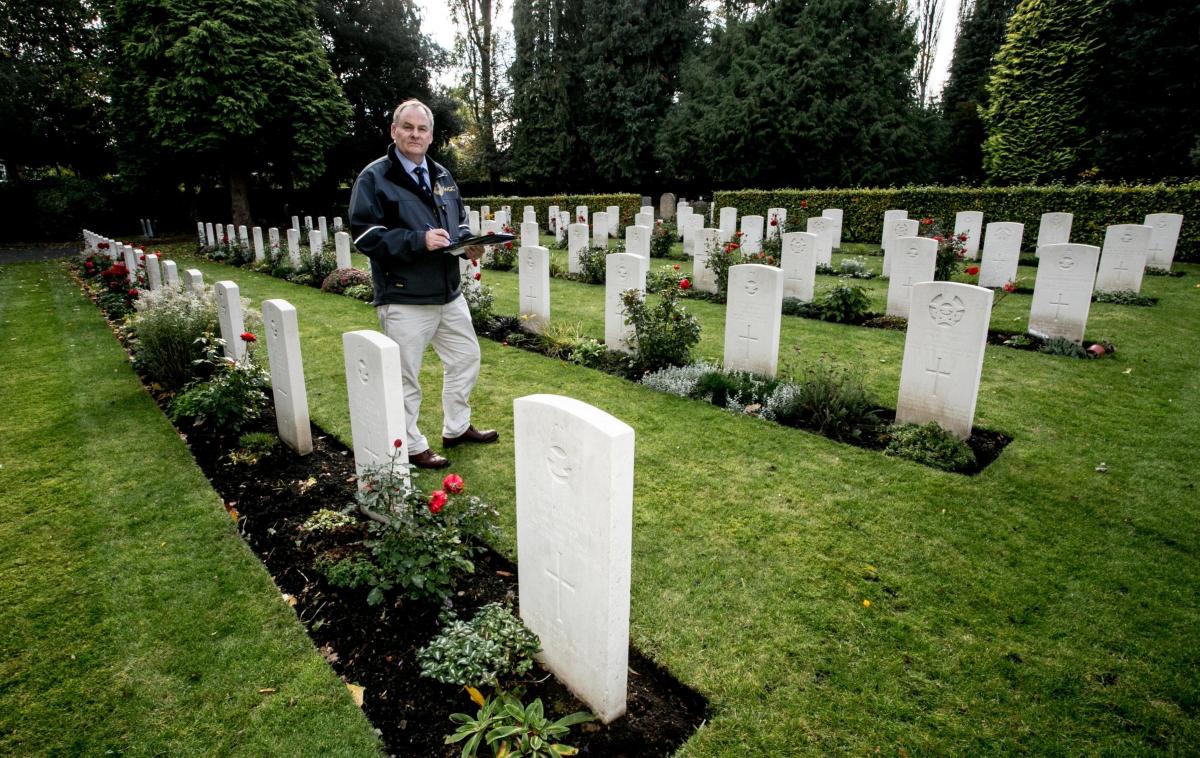THE fallen leaves of autumn are collecting around the feet of the white war headstones which are standing as straight as sentries in Darlington’s West Cemetery.
Stephen Liversage crouches down on the neatly trimmed grass beside one of them, tidies away a few leaves, and says: “From the crown of the headstone, it should 812 millimetres to the back gulley edge of the turf, and the border should be no wider than 60 centimetres and no less than 45 centimetres.
“This makes the soldiers look like they are standing to attention.”

On sale from Wednesday, November 7, our special supplement marking the centenary of the end of the First World War. It costs £1 with 10p from every copy sold going to the Royal British Legion
Stephen is the regional manager of the Commonwealth War Graves Commission and so is responsible for looking after the 43,146 war graves that lie between the Humber and the Tweed.
In the North-East – Tyne & Wear, Durham, Tees Valley and North Yorkshire – he has 11,313 casualties to attend who are buried in 585 sites. In West Cemetery, there are 242 war casualties under his watch – 68 from the First World War and 174 from the second.
Although a database locates every one of them, the Commission’s biggest difficulty comes when a church closes and the graveyard becomes overgrown or sold off – the headstone still has to be cared for.
Stephen’s duty is to ensure that the maintenance contractors keep an adequate path to each headstone and cut a two square metre area of grass in front of it so that the living can honour the dead. He also has to ensure that each headstone is standing the test of time.
“We go round on a cyclical basis every two years inspecting every single headstone in every cemetery or graveyard,” he says, “checking for the legibility of the service number and the name.”
The headstones are under attack from a number of enemies, including the weather, birds, algae, lawnmowers and even floral tributes – the bright red of an artificial poppy drenched in rain and draped for months against a pristine white headstone could leave an ugly stain, and so as Stephen walks around, he can’t stop himself easing a tribute back a few inches so that it is out of range.
“Even when I watch Midsomer Murders, I’m studying the state of the headstones,” he confesses, and in the past five years, more than 900 have failed to pass muster in the North-East and so have had to be replaced.
The biennial check analyses how effectively a biocide spray is keeping the enemies at bay, and it looks at the horticulture at the feet of each headstone.
“The planting is sequenced so we repeat the order of plants every four headstones,” says Stephen, “so it is all very formal and pleasing to the eye.”
It is with some relief that he counts out the red roses – Harkness Remembrance, specially bred for the commission by the famous rose-growers in Hertfordshire – and finds there is precisely one bush every four stones and that no petals are in danger of staining the stone.
“We try to get two plants in front of each headstone, ideally covering the bottom of the headstone so you don’t get any soil splash, but we have to get the mix right so that the horticulture enhances the area but does not take over,” he says. “The first thing you see is the headstones and not the horticulture.”
The commission was established in 1917 and is renowned for keeping the cemeteries of the Somme and Flanders battlefields in immaculate order. Beyond that, it looks after 1.7m graves in 153 countries. Only first and second world war casualties fall beneath its direct remit as men killed in other conflicts are technically Ministry of Defence casualties. The shape of the top of their headstones is slightly different to the war graves, but the commission usually looks after them as well.
It also keeps an eye on private headstones on which a war casualty is commemorated.
“At the time of the death, the family were offered a commission headstone which would be looked after in perpetuity, but over 3,500 in this region didn’t want it and the men are commemorated on their own family memorial,” says Stephen. “They are still war casualties so we still have a commitment to ensuring their names are legible.”
Consequently, West Cemetery has an official war graves plot where regiments of headstones stand to attention, but there are others scattered throughout the grounds.
Another of Stephen’s responsibilities is to the war graves of foreign governments. “In Chevington in Northumberland, we have a plot in which there are Czech, Belgian, Polish and French graves, and we’ve got at least 20 Germans in this region,” he says.
These are usually airmen who crashed on our soil, or of prisoners of war who died here or, in the case of the Belgians, of munitions workers who fled to Britain when their country was overrun. West Cemetery contains three Belgian war graves and one German.
(The German is Werner Deutschmann whose headstone records that he was 21 when he died on Saturday, July 13, 1946. There are no other known facts about him – it is said that he died of TB when a PoW – but his name is suspicious. Deutschmann is obviously German and Werner can mean “warrior”. So is this the grave of a “German warrior” whose real name is unknown?)
The British headstones around the world are a dignified white and, as everyone knows, made from Portland Stone. On hearing this assertion, the equivalent of the QI klaxon goes off in Stephen’s head.
“We have at least seven or eight different types of stone in the region,” he says. “Portland from the south coast tends to be Second World War headstones in our region, and most of the First World War ones are made of Stancliffe stone, which is a York stone – after the war, they shared out the quarrying workload across the country.”
Indeed, in the early 1920s, the commission sourced white stone from anywhere it could. As Stephen walks through the cemetery, his experienced eye – he has worked for the commission for 36 years and his father for 30 before him – picks out the different types.
There’s Pte T Holborn, 24, of the DLI who died on March 8, 1919, and lies beneath a warm grey-white Stancliffe stone. There’s a hint of brown soil splash at the bottom and a little green algae growing inside the DLI badge, but the York stone is wearing well – a part from where a clumsy mower man has knocked out chips out of it at blade-height.
There’s Pte Charles Preston, 27, of the DLI who died on December 24, 1915, and now lies beneath a Botticino brown-white stone. “It’s an Italian stone which was used as instead of Portland,” says Stephen, running his hand over it. “It’s more like a marble, and it’s not very good.” It appears to be soaking up brown water from the ground and brown algae is creeping down from the top.
And there’s Pte William Guy, 41, of the Royal Defence Corps who died on May 5, 1920, and left his widow in Staindrop Road. He now lies beneath a starkly grey-white Vratza stone from Bulgaria.
“We only used it for two or three years,” says Stephen. “Our only task is to commemorate the soldier so it doesn’t matter what the stone is.”
Botticino, Vratza, Stancliffe or Portland, DLI or RAF, British or German, first or second, young or old, all of the fallen are equal, and the commission ensures that they are all equally remembered on a dignified, legible headstone.









Comments: Our rules
We want our comments to be a lively and valuable part of our community - a place where readers can debate and engage with the most important local issues. The ability to comment on our stories is a privilege, not a right, however, and that privilege may be withdrawn if it is abused or misused.
Please report any comments that break our rules.
Read the rules here